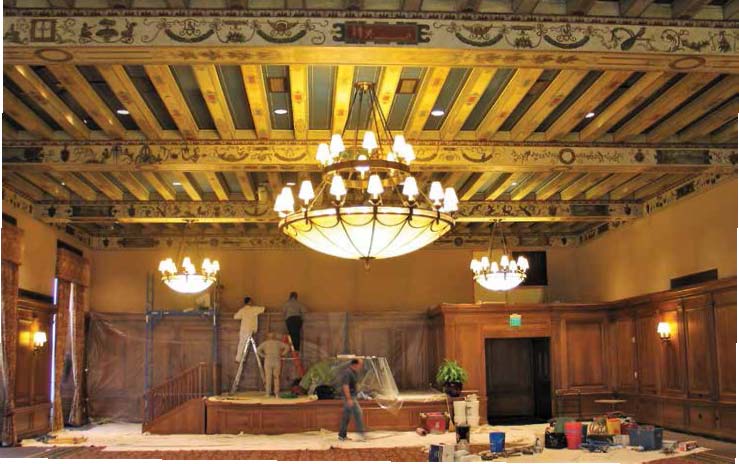THE inPAINT INTERVIEW: ARCHITECTURAL CONSERVATOR
 Thirty years ago, Ron Koenig was inspired to pursue a career in architectural restoration and conservation following a project he worked on at the Michigan State Capitol. It was there he learned how to stencil, glaze, and perform other decorative painting techniques to preserve the historic building, which was constructed in 1877. Today, Koenig is a highly skilled architectural conservator and owner of Building Arts & Conservation Inc. The Michigan-based consulting firm and contracting company maintains an impressive restoration portfolio that includes courthouses, museums, libraries and churches, along with other notable buildings.
Thirty years ago, Ron Koenig was inspired to pursue a career in architectural restoration and conservation following a project he worked on at the Michigan State Capitol. It was there he learned how to stencil, glaze, and perform other decorative painting techniques to preserve the historic building, which was constructed in 1877. Today, Koenig is a highly skilled architectural conservator and owner of Building Arts & Conservation Inc. The Michigan-based consulting firm and contracting company maintains an impressive restoration portfolio that includes courthouses, museums, libraries and churches, along with other notable buildings.
WHAT IS THE NATURE OF YOUR WORK?
We specialize in the conservation of historic architectural materials and help our clients preserve buildings and structures. We investigate, analyze and assess materials and provide planning support, project management, and hands-on restoration and conservation, while following the guidelines set by the American Institute for Conservation of Historic and Artistic Works (AIC).
Not only do we remove paint, but we document the original type of paint and determine how it was applied. The most popular type of paint used in the United States prior to 1930 was calcimine paint, which was often applied to ceilings and other high areas. Milk-based paints, which were very durable, were also prevalent hundreds of years ago. When we work on a historic project, we carefully examine the paint under a microscope to successfully replicate and achieve the structure’s architectural features.
Our restoration services also extend to other materials such as plaster, wood, metallic leaf, glazes, stencils, metals, glass and masonry.
DO CONTRACT REQUIREMENTS FOR HISTORIC PROPERTIES DIFFER FROM COMMERCIAL AND/OR RESIDENTIAL WORK?
Yes. Contracts and specifications for historic properties can differ from standard commercial/residential work and will often contain preservation-specific language that helps protect the building from damage as a result of unqualified contractors.
In general, we find that building owners, architects, and general contractors use information provided in the Secretary of the Interior’s Standards for Rehabilitation, and sometimes the code of ethics from the AIC to ensure that the preservation goals of the project are clear and accountable. We believe that the best contracts will have input from specially trained preservation professionals before a bid is submitted.
DO YOU EXCLUSIVELY HIRE PAINT CONTRACTORS WHO ARE TECHNICALLY SKILLED IN HISTORIC PRESERVATION AND, IF SO, WHY?
We look for paint contractors who have experience working on historic structures with historic materials because they often have greater sensitivity to our goal of preserving as much original material as possible and making sure the treatments are in line with the original intent.
And we seek technically skilled paint contractors who are willing to learn more about how to apply their knowledge and provide on-the-job training so the project can be successful. We like to build relationships with painters and other trades so when a project becomes available we can identify the right contractor(s) to bring on board.
WHAT ARE SOME OF THE CHALLENGES AND UNIQUE REQUIREMENTS OF PROJECTS IN THIS NICHE MARKET?
As you can imagine, there are many obstacles we face when we try to restore or replicate a look using modern materials. We first establish a target date, which means that we don’t necessarily restore the structure to the date it was built, but to an important point in history.
This past year, we worked on the Intramural Sports Building at the University of Michigan, which was originally built in 1928. We were tasked with recreating a cement ceiling that had the appearance of wood. We had to paint, glaze and texturize drywall to achieve an aged look.
Another time, a project involved replicating the look of stone at an old church. We were able to gather paint chips to analyze the coating, however, the paint that was often used many years ago is no longer practical or safe. After we prepped and applied new paint to the surface, Sherwin-Williams was able to formulate a special glaze in their factory to match the oil paint. Then we spray-applied sand that we gathered from the local area and scored the surface to imitate the original stone look.
We are also reviewing a project on a Coca-Cola sign from 1906 that is situated over a flowing river. The challenge is accessing the sign and determining how to paint on a brick wall while holding our brushes steady. It is also very important that the job is financially viable because we will be working with a small town on a tight budget.
Fortunately, we have developed really great relationships with local artists, carpenters, painters, plasterers and riggers who we can subcontract on these types of unique projects.
WHAT IS THE KEY TO SUCCESSFUL SURFACE PREPARATION?
It’s important to first stabilize old painted surfaces before cleaning and applying a new preservative surface paint, and this brings up an interesting point about applying different kinds of paint over one another. Historic surfaces were often ‘glazed,’ which consists of applying a thin, tinted, translucent paint over another opaque paint color. This allowed the lower color to come through, creating a very rich and interesting surface with a lot of depth. To recreate this effect, we generally use high-quality modern latex paint as the base. When this is dry in two to three hours, we are able to immediately apply an oil glaze directly over it. Though the base sets fast, the oil glaze dries more slowly, allowing us time to create the look we want. Being able to apply these finishes so close together saves time and money, but also brings old processes and new processes together very well.
________________________________________________________________________________________
 Ron Koenig began his conservation career in 1988 as an artisan working with John Canning & Company and, later, under painting conservator Darla Olson. He subsequently achieved a master’s degree in architectural conservation from the University of Pennsylvania and has since worked on the restoration and conservation of several notable buildings, including the Wisconsin State Capitol, Frank Lloyd Wright’s Avery Coonley House, the Midland County Courthouse, Meadow Brook Hall, and the Detroit Athletic Club. BLDGConservation.com
Ron Koenig began his conservation career in 1988 as an artisan working with John Canning & Company and, later, under painting conservator Darla Olson. He subsequently achieved a master’s degree in architectural conservation from the University of Pennsylvania and has since worked on the restoration and conservation of several notable buildings, including the Wisconsin State Capitol, Frank Lloyd Wright’s Avery Coonley House, the Midland County Courthouse, Meadow Brook Hall, and the Detroit Athletic Club. BLDGConservation.com




